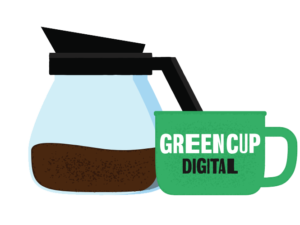Great content sits at the heart of every successful small business digital marketing strategy. The words you use on your website, in social media posts, and through email marketing have the power to transform captions into cash and lines of text into sales. The trouble is, most small business owners don’t possess the desire or skills to consistently crank out quality content for their customers to enjoy. It’s like Ralphie and his classmates when Miss Sheilds tells them to write a theme – groans all around!
With a few well-placed small business content strategies and tools at your fingertips, you can take your C+ content and elevate it to positive earning potential. All it takes is a little time, practice, and preparation. Let’s dive in!
Content Variety
You may be wondering, why bother? I’m a busy, confident entrepreneur. My products and services speak for themselves!
Allow us to explain.
1. Search engines love (and depend on) content, as we talked about in our last installment of the GreenCup Digital Marketing Series. If you want to rank on the first page of Google, you need fresh, diverse content showing up consistently on your website.
2. Design alone will never be enough to sell your products and services. Customers want to hear the “why” and passion behind your business. They want to understand the details and learn exactly what they’re buying before they buy it.
3. Content builds credibility both with consumers and search engines. The more you publish, link to pages of authority, and effectively communicate your knowledge, the more likely your audience will learn to trust you as an expert in your field.
4. Your customers want to communicate with you. One of the best ways to enhance customer relations is with enjoyable content they can relate to, discuss, and share.
5. Growth happens through collaboration and diverse ideas. Crafting content is one way of opening a window of opportunity that allows you to receive pointed feedback, requests, and suggestions.
As confident entrepreneurs with genius ideas, you’ll be delighted to learn the more variety you have in your content strategy, the better! Content diversification allows you to connect to a broader set of customers while simultaneously segmenting your content into various buckets and priorities. For example:
- Want to attract more inbound, organic traffic to your website? A blog would be perfect for you.
- Interested in reaching industry professionals during the workweek? LinkedIn is the perfect place to prioritize your content efforts.
- Find yourself collecting email addresses at trade shows or networking events? Start an e-newsletter to keep your contacts up to date.
Other examples of helpful content include free or paid downloads for your customers, videos, tutorials, landing pages for giveaways, events, or product launches, and guest articles for other websites (remember – Google loves backlinks!).
Content Tone
Once you’ve nailed down the types of small business content to focus on, it’s time to choose your tone. The best way to identify the right tone for your business is by identifying your ideal client and tailoring your words to match their needs and personality. Creating personas, or imaginary profiles built around your target audience, helps keep track of the various tones you want to strike for each piece of content you develop.
Let’s say you sell donuts shaped like unicorn horns. Your target population includes pre-teens. You might develop a persona called, “Emily,” complete with information about Emily’s age range, family structure, likes and dislikes, and needs as a customer. You can get as in-depth with Emily’s background as you’d like; the more detailed you are, the more specific you can be with your tone.
Let’s also assume you also want to target your donut marketing toward parents of pre-teens. This inspires a new persona, one based on an imaginary customer we’ll call David. David is a dad of 3 who is also involved in PTO and coaches softball. He has a vastly different set of likes, dislikes, and needs as a customer.
The tone you take when addressing David should undoubtedly differ from the tone you take when addressing Emily. Instead of engaging with a dancing donut video on TikTok, David would likely respond better to emailed coupons, blogs detailing your magical donut ingredients, and landing pages for parent-and-child events.
Your tone needs to match your desired audience. Don’t be afraid to get inventive and try a few different personas to test the waters of your content strategy. The more diverse you are with your tone, the larger the population of potential customers you’ll reach.
Content Professionalism
One of the quickest ways to lose customers is by pushing out content filled with typos, misspellings, and poor grammar. You want your business to be a leader in your industry. Don’t tarnish your good name by hitting “post” before you’ve done your homework.
Check, recheck, and check your work again before publishing anything to your customers. Utilize free online tools, like Google’s spelling and grammar checker or Grammarly’s browser plug-in, to check your blog posts, newsletters, infographics, or photo captions. Have a coworker or partner help you proofread. Invest in a professional editor to help fine-tune your content. Whatever you do, ensure your content presents your business in the right light – poised, pleasant, and professional.
Content Publishing Schedule
You’ve decided on the types of content you want to publish, you’ve identified the tone you want to take, and you’ve created a few pieces of content that are perfectly and professionally worded. You’re done now, right? Wrong!
We can’t say it enough: Google likes fresh content on a consistent basis. Your customers like it too; it gives them the opportunity to connect with your products and services more regularly. Apple didn’t become a household name by writing a blog post once every 6 months. They became leaders in their industry by consistently publishing diverse, attention-grabbing, branded content for multi-faceted target audiences.
Unfortunately, there’s no one-size-fits-all recommendation for content frequency. The number of times you post, send, or share content depends entirely on your business structure, audience, and business goals. A good rule of thumb is to try and publish new content as much as possible through a variety of channels. Maybe you post to Instagram 4 times a week, publish a blog on your website once a week, and send out an e-newsletter biweekly. Just like with tone, get creative and stay flexible at first with your content frequency. It might take a couple of tries before you define what is sustainable and works best for your small business goals.
Need more ideas on how to develop and publish the best content for your small business? GreenCup Digital offers a variety of content services, including copywriting, editing, and email marketing. Get a detailed picture of your overall digital impact with a Digital Marketing Audit, where we dive deep into your content’s brand positioning, lead generation, and conversion capabilities. GreenCup Digital’s expert wordsmiths are ready to enhance your content with dedicated, results-driven strategies so you can earn the most possible revenue from every word. Connect with us here to learn more about GreenCup Digital’s content services, and don’t forget to tune in for our latest and final installment of the GreenCup Digital Marketing Series, where we walk you through our favorite social media management tricks!







